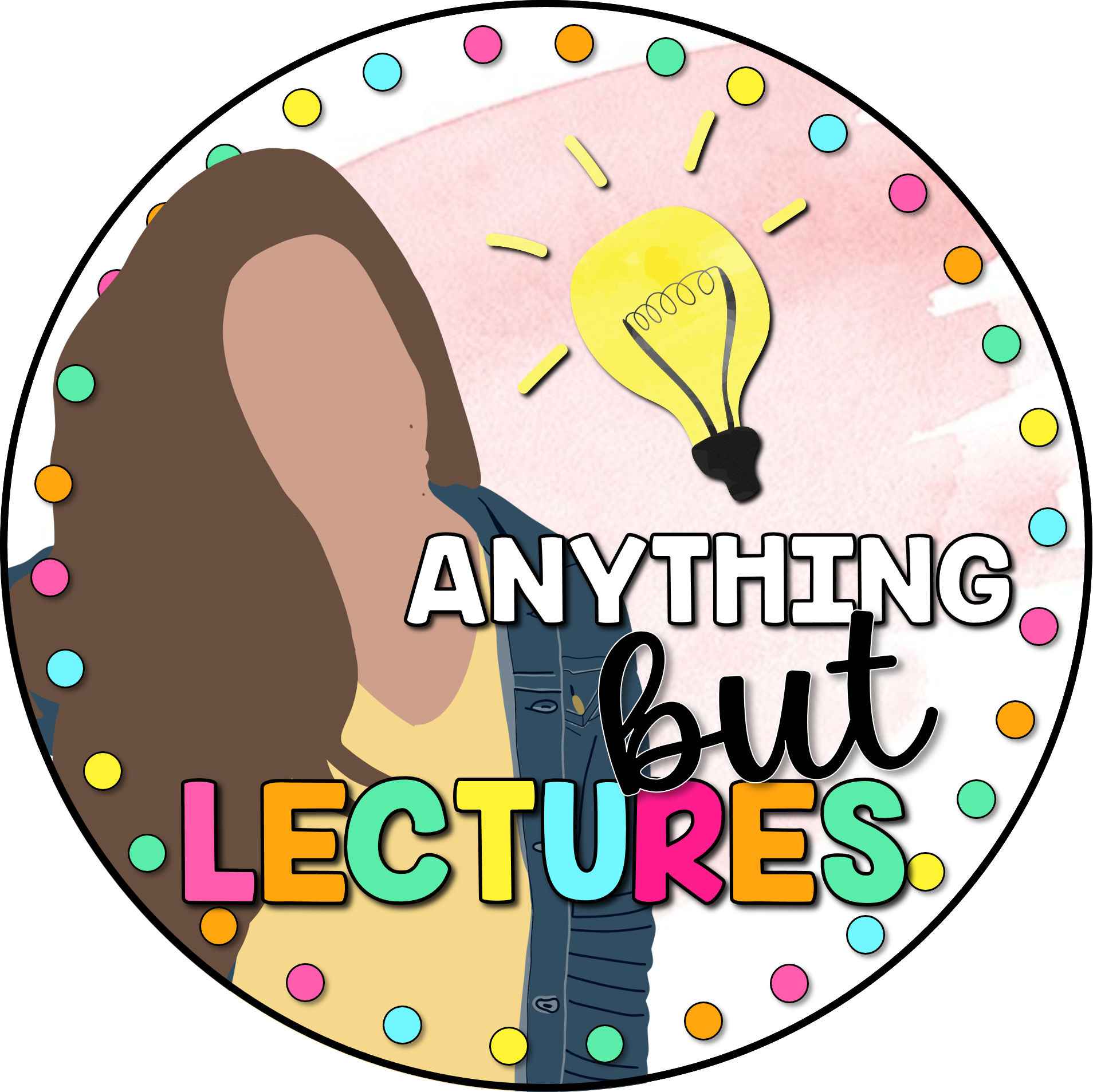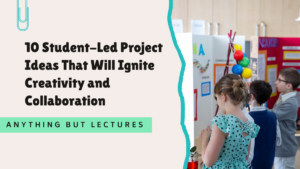Are you looking for exciting and innovative student-led project ideas to engage your students and nurture their creativity? Look no further! In this blog post, I have compiled a list of 10 student-led project ideas that will ignite creativity and foster collaboration in the classroom.
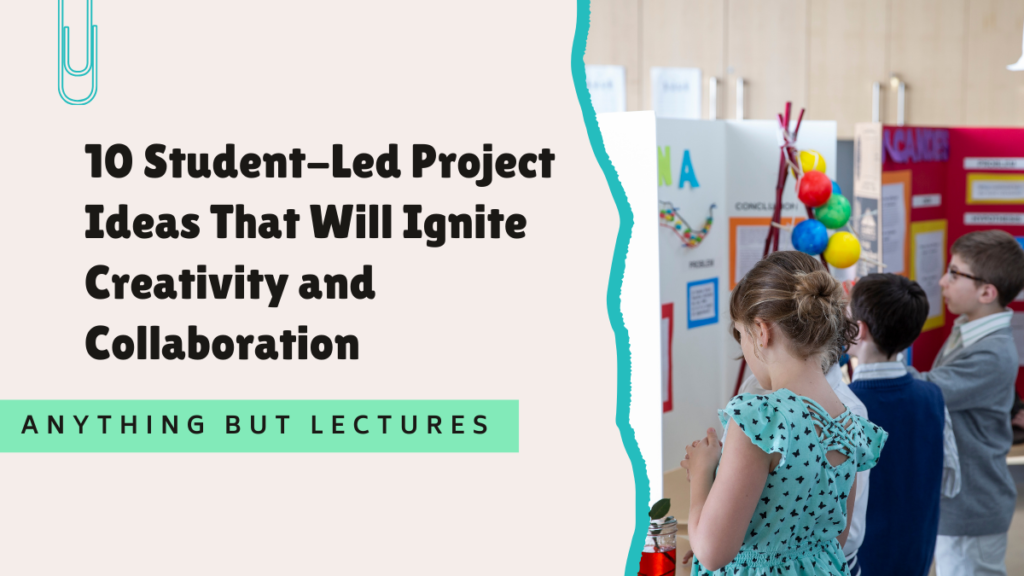
These project ideas are designed to empower students and encourage them to take ownership of their learning. From creating a digital magazine to organizing a TEDx event, each project provides a unique opportunity for students to explore their interests and develop important skills such as critical thinking, problem-solving, and teamwork.
With these project ideas, students will not only gain subject knowledge but also develop 21st-century skills that are vital for their future success. These ideas will inspire and motivate you to think outside the box and embark on exciting educational journeys.
So, let’s dive in and discover the incredible world of student-led projects that will unleash the creativity and collaboration within your classroom!
Need a refresh of your student-led teaching practices? Join the 10-day Student Curiosity Challenge for Educators! Each day will bring a new challenge that will get you, your students and your classroom in the creative zone. Download now for FREE!
Importance of student-led projects
In today’s rapidly evolving world, the traditional lecture-based approach to education is no longer cutting it when it comes to preparing students for the challenges of the 21st century.
Students need to develop a diverse set of skills, including critical thinking, problem-solving, collaboration, and creativity, to thrive in their personal and professional lives.
Student-led projects offer a powerful solution to this challenge. By empowering students to take an active role in their learning, these projects foster a sense of ownership and engagement that is often lacking in traditional classroom settings.
When students are given the opportunity to explore their interests, identify problems, and devise innovative solutions, they not only gain subject-specific knowledge but also build essential life skills that will serve them well in the future.
Furthermore, student-led projects:
- encourage students to take risks
- embrace failure as a learning opportunity
- develop a growth mindset
These skills are invaluable in a world that is constantly evolving, where the ability to adapt and innovate is key to success. By nurturing these qualities, student-led projects prepare students to navigate the complexities of the modern world and become active contributors to their communities.
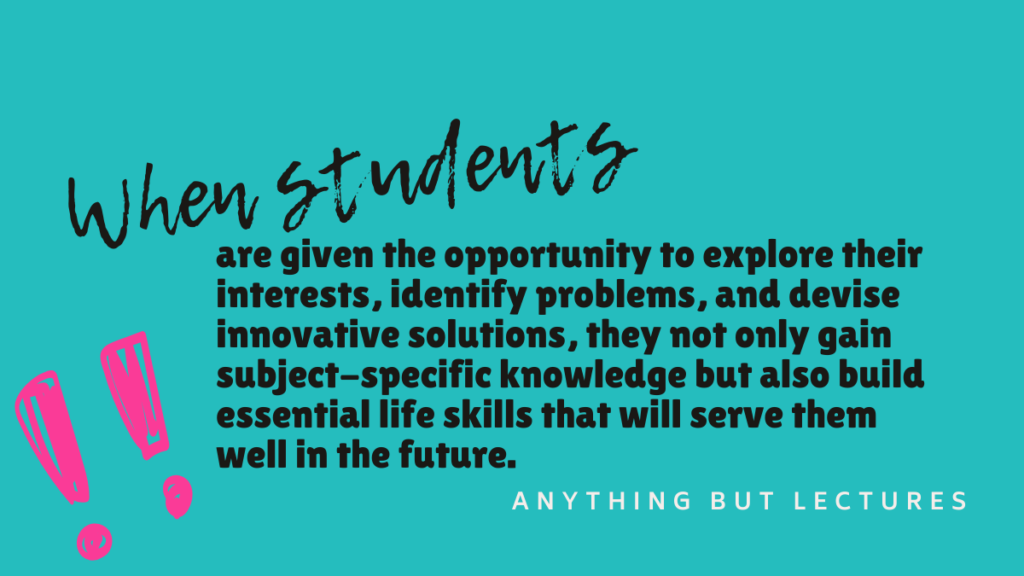
Characteristics of successful student-led projects
Successful student-led projects share several key characteristics that make them effective.
Firstly, they are anchored in real-world problems or challenges that are relevant and meaningful to the students. By addressing issues that have a tangible impact on their lives or communities, students are more invested in the project and more motivated to find solutions.
Secondly, successful student-led projects encourage collaboration and teamwork. Students are often organized into groups or teams, where they learn to communicate effectively, delegate responsibilities, and leverage each other’s strengths to achieve a common goal. This collaborative approach not only fosters essential 21st-century skills but also helps to build a sense of community and camaraderie within the classroom.
Finally, successful student-led projects provide opportunities for reflection and iteration. Throughout the project, students are encouraged to regularly assess their progress, identify areas for improvement, and make adjustments to their plans and strategies. This process of reflection and refinement not only helps students to develop critical thinking skills but also instills a growth mindset, where failure is seen as an opportunity for learning and growth.
Project-based learning vs. traditional learning
While traditional learning approaches, such as lecture-based instruction and rote memorization, have their place in the classroom, project-based learning offers a more dynamic and engaging alternative. In a traditional learning environment, students are often passive recipients of information, expected to regurgitate facts and concepts during assessments. In contrast, project-based learning places students at the center of the learning process, empowering them to take an active role in exploring and understanding the subject matter.
One of the key differences between project-based learning and traditional learning is the focus on real-world application. While traditional learning may prioritize the acquisition of knowledge, project-based learning emphasizes the ability to apply that knowledge to solve complex problems. Students are encouraged to think critically, collaborate with their peers, and find creative solutions to challenges that are relevant to their lives and communities.
Moreover, project-based learning fosters a deeper understanding of the subject matter. By engaging in hands-on, experiential learning, students are able to make meaningful connections between the concepts they are studying and their practical applications. This not only leads to better retention of knowledge but also helps to develop a more nuanced and comprehensive understanding of the subject.
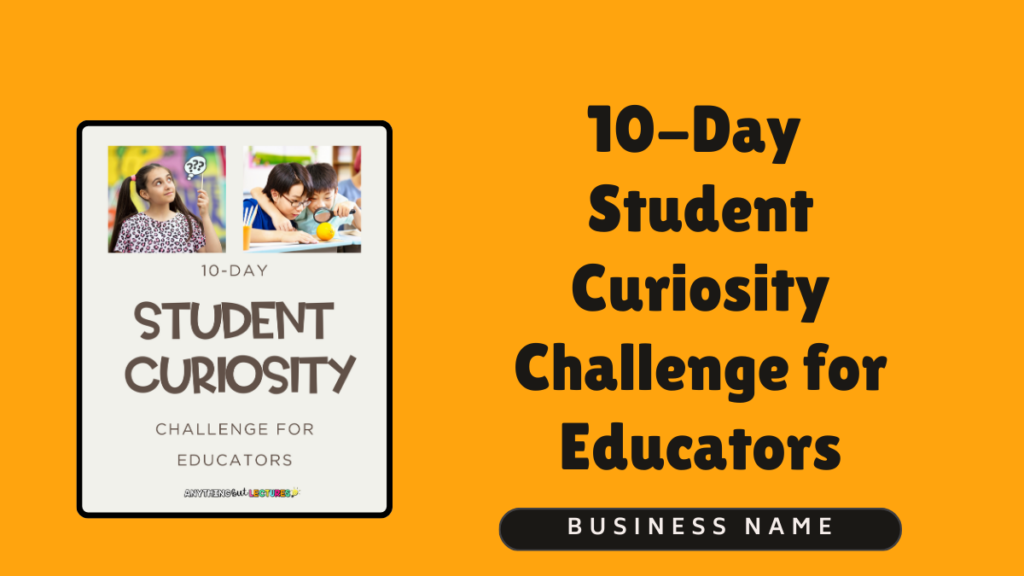
10 student-led project ideas
- Community Problem-Solving Challenge: Partner with a local non-profit or community organization to identify a specific problem they face. Students research potential solutions, present their ideas, and potentially even implement the most feasible one.
- Choose Your Own Adventure Story Video Game: Leverage online coding platforms to create a choose-your-own-adventure video game based on a literary classic or historical event. This merges storytelling, coding skills, and interactive learning.
- Reverse Field Trip: Instead of a traditional field trip, students research and create a presentation for a local business or organization about a relevant topic. This flips the script, allowing students to become the experts and build communication and presentation skills.
- Coding Club: Students can create a coding club, where they learn and apply programming languages to develop their own applications or games. This project allows students to explore their interests in technology and develop valuable coding skills.
- Escape Room Challenge: Design an escape room experience around a historical period, scientific concept, or literary work. Students create puzzles, clues, and challenges that their peers must solve using their class knowledge.
- Augmented Reality Scavenger Hunt: Students create an AR scavenger hunt around the school or local area using a free AR creation platform. Clues and challenges can be tied to curriculum content, promoting engagement and location-based learning.
- Podcast Series: Students research and produce a podcast series on a topic relevant to their class or a current event. This fosters research, communication, and audio editing skills.
- Robotics Competition: Students can form a robotics team and participate in a robotics competition, where they design, build, and program their own robots. This project combines engineering, coding, and problem-solving skills.
- Social Justice Documentary: Students can create a documentary that explores a social justice issue, such as racial inequality or gender discrimination. This project allows students to develop their research, filmmaking, and advocacy skills.
- Citizen Science Project: Students can participate in a citizen science project, where they collect and analyze data to contribute to real-world scientific research. This project engages students in the scientific process and helps them develop critical thinking and data analysis skills.
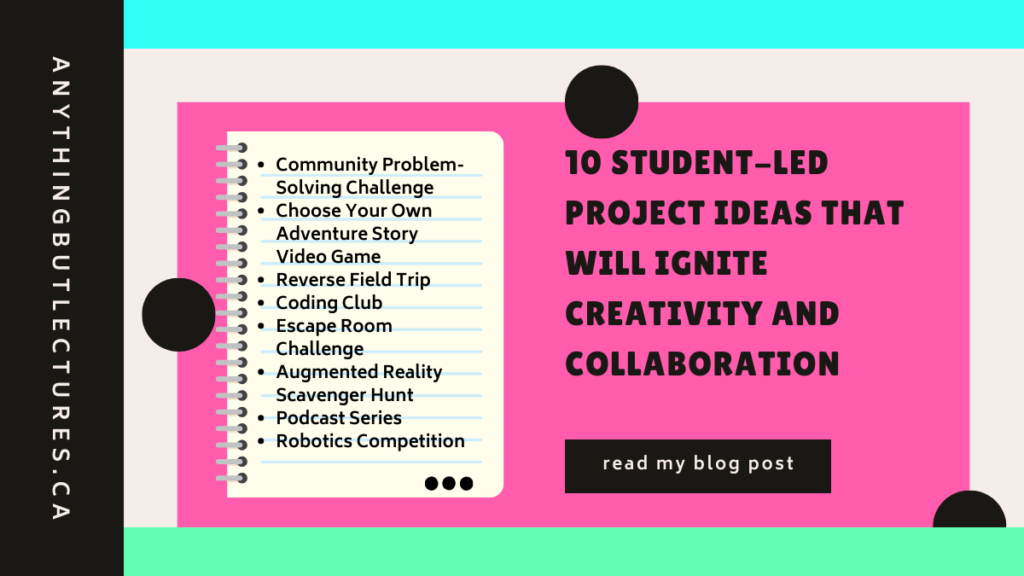
How to implement student-led project ideas in the classroom
Implementing student-led projects in the classroom requires a shift in the traditional teaching and learning dynamic. Instead of the teacher being the sole source of knowledge and authority, the teacher becomes a facilitator, guiding and supporting students as they take ownership of their learning.
The first step in implementing student-led projects is to create a supportive and collaborative classroom environment. This involves establishing clear expectations, encouraging open communication, and fostering a growth mindset where mistakes are seen as opportunities for learning. By creating a safe and inclusive space, students will feel empowered to take risks and explore their interests.
If you worry your students are not ready to take on a project like this, check out the free 10-day Student Curiosity Challenge for Educators.
Next, teachers should provide students with the necessary resources and scaffolding to ensure the success of their projects. This may include offering workshops on project management, research skills, and presentation techniques, as well as providing access to relevant materials and technologies. Additionally, teachers should regularly check in with students, offer feedback, and help them navigate any challenges they may face.
Tools and resources for student-led projects
Implementing successful student-led projects requires access to a variety of tools and resources. Here are some examples of the tools and resources that can support student-led projects:
- Project Management Tools: Tools like Trello, Asana, or Google Sheets can help students organize their tasks, track their progress, and collaborate effectively.
- Research Tools: Online databases, academic journals, and reference management software like Zotero or Mendeley can assist students in conducting thorough research for their projects.
- Presentation and Visualization Tools: Tools like PowerPoint, Canva, or Prezi can help students create engaging and visually appealing presentations to showcase their work.
- Collaboration Tools: Tools like Google Docs, Microsoft 365, or Slack can facilitate real-time collaboration and communication among student teams.
- Multimedia Tools: Tools like Adobe Creative Cloud, iMovie, or Screencast-O-Matic can enable students to create high-quality multimedia content, such as videos, podcasts, or digital stories.
- Funding and Grant Resources: Websites like DonorsChoose or GoFundMe can help students secure funding for their projects, while organizations like the National Education Association Foundation offer grants for student-led initiatives.
- Community Partnerships: Connecting with local businesses, non-profit organizations, or community leaders can provide students with valuable resources, mentorship, and real-world learning opportunities.
- Professional Development for Teachers: Workshops, conferences, or online courses can help teachers develop the necessary skills and strategies to effectively implement and support student-led projects in their classrooms.
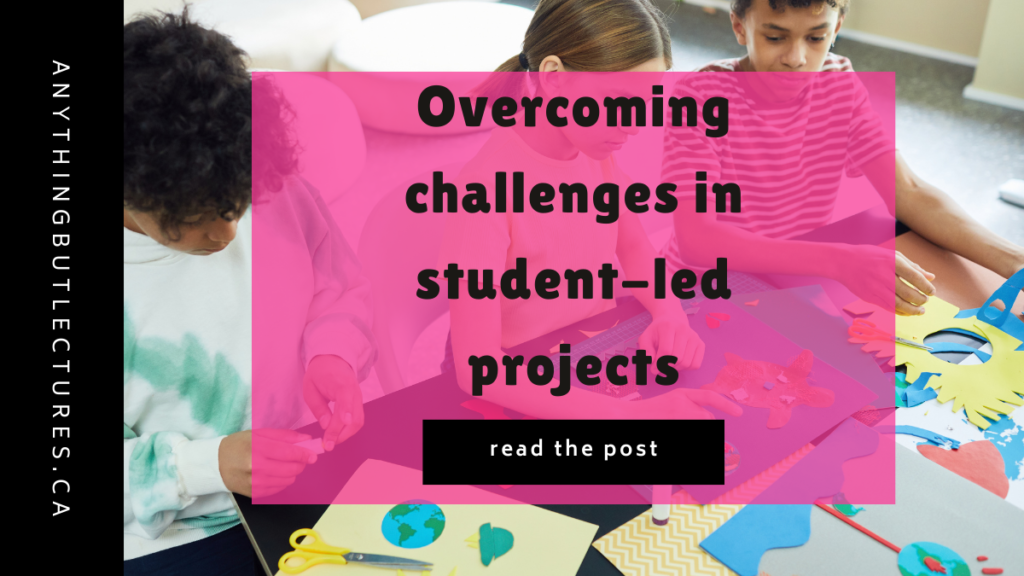
Assessing student-led projects
Assessing student-led projects requires a multifaceted approach that goes beyond traditional tests and quizzes. Instead, teachers should focus on evaluating the process, the final product, and the development of essential skills.
One effective method of assessment is the use of rubrics. Rubrics provide a clear and transparent framework for evaluating student work, outlining the criteria for success and the various levels of achievement. By involving students in the development of these rubrics, teachers can foster a sense of ownership and ensure that the assessment aligns with the project’s goals and learning objectives.
In addition to rubrics, teachers can also incorporate peer and self-assessment into the evaluation process. By asking students to reflect on their own work and provide feedback to their peers, teachers can encourage critical thinking, foster a growth mindset, and promote a culture of continuous improvement.
Overcoming challenges in student-led projects
Implementing student-led projects in the classroom is not without its challenges. One of the primary challenges is managing the increased level of autonomy and responsibility given to students. Teachers may need to provide more scaffolding and support to ensure that students stay on track and meet their goals.
Another challenge is ensuring that all students are actively engaged and contributing to the project. This may require teachers to implement strategies for promoting equal participation, such as rotating roles or incorporating individual accountability measures.
Finally, managing the logistics of student-led projects, such as scheduling, resource allocation, and presentation scheduling, can be a significant challenge. Teachers may need to work closely with school administrators and community partners to secure the necessary resources and support to ensure the success of these projects.
Conclusion: Empowering students with these student-led project ideas
In conclusion, these student-led project ideas offer a powerful and transformative approach to education, empowering students to take an active role in their learning and cultivating the essential skills needed for success in the 21st century. By embracing project-based learning, educators can foster creativity, collaboration, and critical thinking, while also nurturing a sense of ownership and agency in their students.
As we have seen, the benefits of student-led projects are numerous and far-reaching, from the development of essential life skills to the deeper understanding of subject matter. By implementing these projects in the classroom, teachers can create dynamic and engaging learning environments that inspire students to explore their interests, tackle real-world challenges, and become active contributors to their communities.
While the implementation of student-led projects may present some challenges, the rewards far outweigh the obstacles. By embracing this approach and providing the necessary support and resources, educators can empower their students to become the innovators, problem-solvers, and leaders of tomorrow. So, let us embark on this exciting journey of student-led projects and unlock the boundless potential of our learners.
Click here to download the free 10-Day Student Curiosity Challenge for Educators!
Check out these related blog posts:
